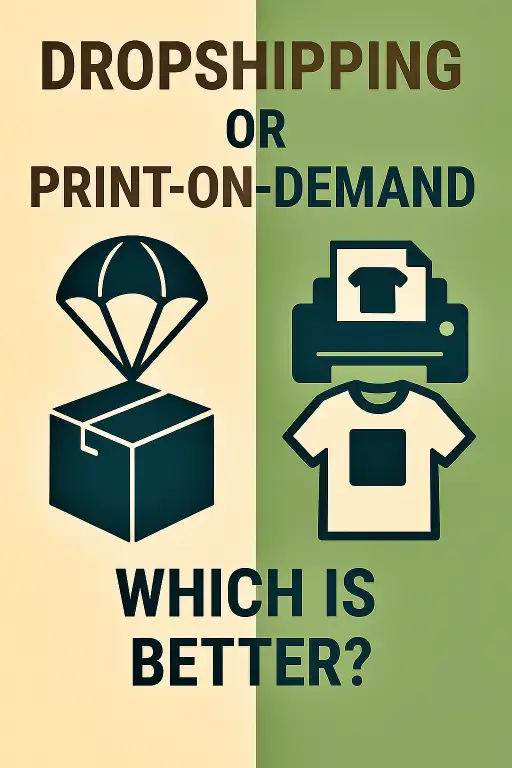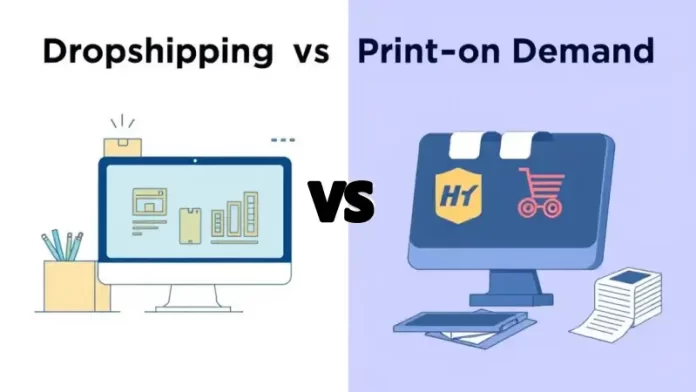Dive into the world of e-commerce, dreaming of that sweet sound of online sales notifications hitting your phone. Welcome to the club! Starting an online business startup is more accessible than ever, especially with models that don’t require you to have a garage crammed floor-to-ceiling with inventory. Two titans in this low-inventory arena constantly go head-to-head: Dropshipping and Print-on-Demand (POD).
But here’s the million-dollar question (or at least, the “save-me-a-ton-of-headaches” question): Dropshipping vs Print-on-Demand: Which is better? Which one will get your online empire off the ground faster, build a stronger brand, or ultimately, put more money in your pocket?
Let’s be real, there’s no single “winner” that fits everyone. It’s like asking if pizza is better than tacos depends on what you’re hungry for! So, let’s break down both of these ecommerce fulfillment models, lay out the pros and cons, and help you figure out which one aligns best with your brilliant business idea.
Table of Contents
Diving Deep: What Exactly IS Dropshipping?
First up, let’s demystify dropshipping. In a nutshell, it works like this:
- You, the savvy online store owner, list products for sale on your website (e.g., on Shopify, WooCommerce, or even marketplaces like Amazon or eBay). You don’t actually own or stock these items.
- A customer visits your store and buys a product. Ka-ching!
- You then take that order and forward it (along with the customer’s shipping details) to your supplier (often a manufacturer, wholesaler, or another retailer who dropships). You pay the supplier their wholesale price.
- The supplier then packages and ships the product directly to your customer, usually with your store’s branding (if you’ve arranged that, which can be tricky for beginners).
- Your profit is the difference between what the customer paid you and what you paid the supplier.
You are essentially the marketing and customer service front-end; the supplier handles the backend logistics.

The Shiny Side: Pros of Dropshipping
- Super Low Startup Costs: This is the big draw. No need to invest thousands in inventory that might not sell. Your main costs are setting up your website and marketing.
- Vast Product Selection: You can offer a huge range of products because you’re not limited by what you can physically store. Want to sell pet supplies today and kitchen gadgets tomorrow? Go for it (though niching down is usually wiser).
- Highly Scalable: As orders increase, your supplier handles the increased fulfillment. You focus on growing your customer base.
- Work From Anywhere: All you need is a laptop and an internet connection. The dream, right?
- Minimal Risk: You don’t buy the product until someone else has already bought it from you. Less risk of dead stock.
The Not-So-Shiny Side: Cons of Dropshipping
- Slimmer Profit Margins: Because you’re not buying in bulk and acting as a middleman, your profit margins can be tight. You need significant volume to make substantial income. The competition are fierce in popular niches.
- Less Control Over… Well, Almost Everything:
- Branding: Often difficult to build a strong, unique brand when you’re selling generic products shipped by someone else. Custom packaging can be an option with some suppliers, but often not for beginners.
- Product Quality: You don’t physically inspect the items, so you’re relying on your supplier’s quality control.
- Shipping Times & Costs: You’re at the mercy of your supplier’s shipping methods, speed, and costs, which can vary wildly and sometimes be slow, especially if sourcing from overseas.
- Supplier Shenanigans: What if your supplier runs out of stock after you’ve made a sale? Or ships the wrong item? Or their quality drops? These issues reflect directly on your store and your customer service. Finding reliable suppliers is a make-or-break part of dropshipping.
- High Competition: Popular dropshipping products often have many sellers, leading to price wars and making it harder to stand out.
Getting Creative: What’s the Deal with Print-on-Demand (POD)?
Now, let’s switch gears to Print-on-Demand (POD). This model is particularly popular with artists, designers, and creators. Here’s the flow:
- You create original designs (artwork, slogans, patterns, etc.).
- You partner with a POD service (like Printful, Printify, Teespring, Redbubble, or Amazon Merch on Demand). These services offer a catalog of “blank” products t-shirts, hoodies, mugs, phone cases, posters, tote bags, and so much more.
- You upload your designs onto these blank products in your online store (which can be your own website or a marketplace like Etsy).
- A customer sees your awesome design on a t-shirt, loves it, and buys it.
- Only then does the POD service print your design onto the t-shirt and ship it directly to the customer, often with your branding on the packaging or labels.
- Your profit is the retail price minus the POD service’s cost for the blank product, printing, and fulfillment.
You handle the design and marketing; the POD company handles the production and shipping, on demand.
The Artistic Advantages: Pros of Print-on-Demand
- Low Startup Costs & No Inventory: Just like dropshipping, you don’t pay for the product or printing until after you’ve made a sale. Minimal financial risk.
- Strong Branding Potential: This is where POD shines! Your unique designs are your brand. You can build a loyal following around your specific aesthetic or message.
- Creative Freedom & Unique Products: You’re selling something that (hopefully) no one else is. This allows you to stand out and cater to niche markets passionate about your designs.
- Good for Niche Audiences: Got a quirky hobby or a passionate community you want to design for? POD is perfect.
- Scalable Operations: As your sales grow, the POD company handles the increased production and shipping.
The Creative Constraints: Cons of Print-on-Demand
- Lower Profit Margins (Potentially): The cost of the blank product plus the custom printing can eat into your margins. You need to price strategically.
- Limited Product Catalog: You can only sell items that your chosen POD service offers and is capable of printing on. You can’t just decide to sell, say, a custom-designed tent unless a POD provider specifically offers that.
- Dependence on POD Provider: You’re relying on them for:
- Print Quality: Inconsistent prints can damage your brand. Always order samples!
- Blank Product Quality: The t-shirt or mug itself needs to be good.
- Shipping Times & Costs: Since the item needs to be printed after the order, fulfillment times can be longer than for pre-stocked dropshipped items. Sometimes, the lead times is longer than dropshipping significantly.
- Design Skills Required (or Budget for Them): You either need to be a designer yourself or be prepared to hire one. Great designs are the heart of a POD business.
- Order Fulfillment Time: The printing process adds a few days to the fulfillment timeline compared to dropshipping an already manufactured item.
The Showdown: Dropshipping vs. POD Across Key Factors
Let’s put these two low inventory business models side-by-side:
| Feature | Dropshipping | Print-on-Demand (POD) |
|---|---|---|
| Startup Costs | Very Low (website, marketing) | Very Low (website, marketing, potential design costs) |
| Inventory Risk | None | None |
| Product Range | Potentially Huge (depends on supplier) | Limited to POD provider’s catalog |
| Branding Control | Lower (often generic products/packaging) | Higher (your designs, often custom labels/packaging) |
| Creative Control | Minimal (you sell existing products) | Maximum (your designs are the product) |
| Profit Margins | Variable, can be slim (supplier dependent) | Variable, can be slim (product/print cost dependent) |
| Supplier Dependency | High (quality, stock, shipping) | High (print quality, blank stock, shipping) |
| Fulfillment Time | Potentially faster (product is pre-made) | Generally slower (product printed on demand) |
| Ease of Setup | Relatively easy; supplier sourcing can be tricky | Relatively easy; design creation is key |
| Scalability | High (supplier handles fulfillment) | High (POD provider handles fulfillment) |
| Niche Suitability | Broad (any physical product niche) | Strong for design-led, artistic, community niches |
It’s a bit of a “six of one, half a dozen of the other” for some aspects, isn’t it? Both offer low risk and outsourced fulfillment, which is a massive plus. The differences really emerge when you look at product uniqueness and branding.
So, Which E-commerce Model is “Better” For You?
There’s no magic eight-ball answer here. The “better” model depends entirely on your goals, skills, interests, and the kind of business you want to build.
Consider Dropshipping if:
- You’re more interested in marketing and sales than product creation.
- You want the ability to test and sell a wide variety of existing products quickly.
- Your main goal are quick setup and broad offerings without deep brand investment in product design itself.
- You’ve found a niche with reliable suppliers offering decent margins.
- You prioritize potentially faster shipping times (since products are already manufactured).
Consider Print-on-Demand if:
- You are an artist, designer, writer, or have a strong creative vision and want to sell custom product selling opportunities.
- Building a unique brand around original designs is your top priority. Creative expression and brand identity is paramount for you.
- You want to cater to a specific niche or community with tailored merchandise.
- You’re okay with potentially longer fulfillment times in exchange for custom-made products.
- You value having products that are uniquely “yours.”
What About a Hybrid Approach?
Absolutely! Many successful online stores mix and match. You could have a core range of POD products featuring your unique designs, and then dropship complementary items (e.g., a band selling their POD merch could also dropship generic guitar picks or accessories). This can give you the best of both worlds brand building with POD and broader catalog options with dropshipping. Their easier to manage once you have the systems in place.
Quick Tips for Success (Whichever Path You Choose)
No matter which model you lean towards, a few universal truths apply to succeeding in e-commerce:
- Niche Down: Trying to be everything to everyone is a recipe for getting lost in the noise. Focus on a specific audience.
- Marketing is King (and Queen!): Since you’re not handling physical products, your energy needs to go into brilliant marketing and top-notch customer service.
- Vet Your Partners: Whether it’s a dropshipping supplier or a POD provider, do your homework. Order samples. Check reviews. Understand their processes. This is crucial.
- Manage Expectations: Be transparent with customers about shipping times.
- Build a Brand: Even with dropshipping, try to build a brand identity through your website design, content, and customer interactions. With POD, your designs are the brand.
The Final Verdict: Your Business, Your Choice
So, Dropshipping vs Print-on-Demand: Which is better? As we’ve seen, it’s not about one being definitively superior to the other. Both are fantastic low-risk ecommerce models that have empowered countless entrepreneurs to launch their ventures.
- Dropshipping offers incredible breadth and speed to market if you want to sell existing products.
- Print-on-Demand offers unparalleled depth in terms of customization and building a unique, design-led brand.
The best choice are the one that resonates with your skills, passions, and the kind of online business you dream of building. Think about what excites you more: curating and marketing a wide range of products, or designing and selling your own unique creations? Success require dedication either way. Weigh the pros and cons, consider your personal strengths, and then take that exciting leap!

